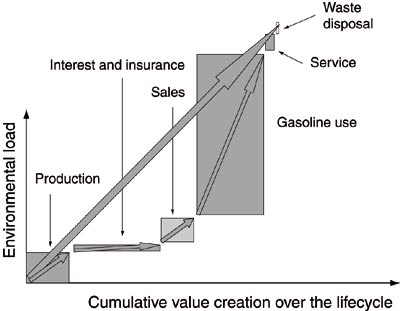4 Presentasjon av nederlandsk prosjekt innen produkttjenestesystemer
Nowadays service sectors become increasingly important in western economies. This means that economy is de-materialising: more money is made with less material products. It is not clear however if this really benefits both economy and ecology.
Knowledge of Product Service System enables governments to formulate a next step in policy concerning sustainable production and consumption patterns. Knowledge of Product Service System enables companies to find strategic options for business growth, renewal, innovation and diversification. It is especially inspiring for those companies who regard sustainability as a co-pilot for management strategies.
Why Product Service Systems?
Product Service Systems can prove beneficial to the environment in combination to creating (new) business. Key factors of success are similar in many cases:
Creating value for clients, by adding quality and comfort
Customising offers or the delivery of the offer to clients
Creating new functions or making smart or unique combinations of functions
Decreasing the threshold of a large initial or total investment sum by sharing, leasing, and hiring
Decreasing environmental load. Often this will bring additional and perceived Eco-benefits
Increase the quality of the contacts with clients
Moreover, the study shows a potential to unlink environmental pressure from economical growth.
Ten cases analysed qualitatively on four axis
The project has resulted in ten case descriptions. Three of these have been worked out quantitatively in terms of economic and ecological characteristics. For analysing these descriptions a new method has been used. Each case is characterised by four axes: an ecological axis, an economic one, an identity/strategy axis and a client acceptance axis. These axes are described in the report. For the ecological and economical axis quantitative methods are proposed as well.
Displaying the unlinking potential with the E2 vector
To get an appealing representation of two core parameters, the economy and ecology axes have been combined. This has resulted in the ratio economic added value (of companies on the network) per unit environmental load, which can be plotted graphically as what has come to be called the E2 vector.
The E2 vector enables benchmarking between a company’s departments, between companies, between economic sectors and between different product service mixes.

Figur 4.1 Environmental load related to cumulative value creation over the lifecycle.
Example of an E2 vector for the life cycle of a car. The vector represents the ratio between environmental load and economic value. Product service systems that create more value at a lower environmental load contribute to unlinking.
The report 1
Apart from case descriptions, the project has resulted in definitions, a database with examples, and policy recommendations for governments and companies. One of the recommendations is to discuss theory in multidisciplinary sessions and to develop practice with Product Service Systems.
The Authors
The report was produced by the following persons:
Cees van Halen; presently working for PriceWaterhouseCoopers
Harry te Riele; Storrm C. S. Consultancy
Mark Goedkoop; PRé Consultants
The project was commissioned by both the Dutch Ministry of Economic Affairs and the Dutch Ministry of Housing, Spatial Planning and the Environment.
Fotnoter
Rapporten er tilgjengelig i PDF-format på http://www.pre. nl/pss/default.htm